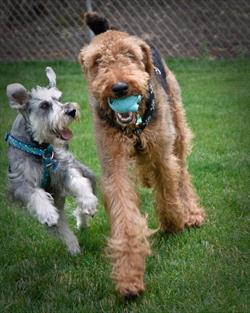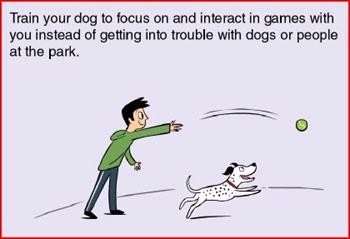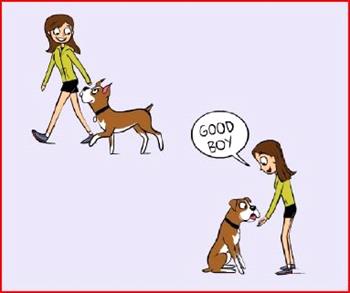Anyone who frequents the dog park and knows about dog behavior probably has a few horror stories to share and I am no exception.
A couple of years ago, I was at my neighborhood park, which is a private multi-use park for dogs and people. It was an off-hour so it was just me, my dog, Jonesy, and my foster dog, a little Corgi with a history of some fear and reactivity to unfamiliar dogs. Jonesy was off-leash and the Corgi was on a long line. Generally, when I’m just with Jonesy, who is reactive towards unfamiliar dogs, especially those who are en route to trampling or side-swiping him, I’ll keep him focused on me in fun games or give him treats. That way Jonesy doesn’t have a chance to feel threatened enough to bark and growl doggie expletives. But in this case, I didn’t know other dogs were entering the area park until I heard the mad barking of three Australian Shepherds as they leapt out of their car and started racing around as if they had been penned up for weeks. The park was the size of a football field, but as usual, these dogs decided that the choice spot was wherever we were, so they sprinted our way. I stood for an instant indecisively. Should I call the Corgi and sprint so he’d follow me (but most likely with the other dogs in hot pursuit) or should I give him a super-slack leash in hopes that he will feel like he can get away and doesn’t need to lunge at or possible bite the furry torpedoes heading our way.
Still unsure, I shouted to the other owner, “My dogs are fearful of other dogs that race up to them,” a tactic that generally works well. Most owners are accommodating, or at least apologetic when their off-leash dogs have charged up. But today I was up against the type of guy for whom workplace sensitivity classes were invented.
“Oh, are they bothering you?” he asks. “You look really scared. Do you want me to leave the park?” He continues in his pretend-nice, voice. I’m thinking, “What normal person notices he is doing something that makes you nervous and hears you verbalize the problem, and then asks you if it’s an issue?”
My reply, “No, you don’t need to leave, but can we have 10 yards of space?” Then his true colors came out. “It’s a DOG park,” he says, emphasizing every word, as if, because I’m a small Asian woman, I’m too stupid to understand English spoken at a normal speed. “They’re supposed to be able to play,” he continues.
That’s what he said, but what he really meant was, “My dogs have no come when called and because of that, they have to hog the entire 100-yard field. Because I have no control of them, I have to pretend that you’re the idiot when I know the real idiot is me.” Sure enough, when he tried to get his dogs to go back to the car, it took him a good five minutes to round them up. (Note he had to get his dogs back into the car in order to have any control over them so that I could leave the park with the corgi).
Download the free poster on Dog Park Etiquette here as part of Dr. Sophia Yin’s Perfect Puppy poster bundle.
How and Why Dogs Should Behave Politely at the Off-Leash Park
Incidents like this happen regularly at a majority of off-leash dog and multi-use parks, resulting in bad experiences for both people and dogs. Many people may pooh pooh the problem and blame other, insecure dogs for being scared. However, when you turn the situation around and imagine we were talking about kids at the playground, it would all seem very different.
Take these scenarios, for example:
Scenario 1:
At the dog park, avoid letting your dog mob dogs that enter the park and avoid letting them sprint up to other dogs they don’t know. Watch how the other dogs respond to your dog’s greeting and look for signs of fear or anxiety in them (Read the blog on body language of fear and anxiety and download the free poster)
Scenario 2:
If your dog has a tendency to steal toys or even crowd other dogs who are playing with toys, you’ll need to develop a fantastic come when called and fetch so that he can bring the toy to you and you can get it back to the rightful owner. You may need to leash your dog if he’s a toy thief because it’s not fair for him to disrupt other dogs’ play.
Scenario 3:
If your dog is a pest you’ll want to call him and engage him in more appropriate play with you or a toy.
Scenario 4:
In fact, in my experiences, overly rough play is a leading cause of deteriorating behavior at the park. One dog’s having fun but the other is getting trampled, or both dogs are getting too excited and suddenly their play breaks into a fight. To prevent this from happening, you’ll want to call your dog over to you and engage him in replacement behaviors before he gets overly rough with others.
Scenario 5:
A park is for multiple uses, even if it’s a dog park. Dogs should avoid hogging the entire field. Give dogs that are playing fetch room to play and let dogs that are interacting with their people interact on their own.
Scenario 6:
While most people at the dog park like dogs, most people dislike being body slammed or jumped on. In fact, these rude behaviors can cause injury to people. I’ve even seen this injury cost $40,000 for the negligent owner of the dog. The solution? Train your dog to greet people by sitting politely or call him away from them before he can jump or body slam them.
Scenario 7:
Probably the number one reason dogs get into trouble at the park is that people stand around and ignore them. Behind their back, multiple small altercations are happening or the dog’s being rude and other dogs are just too polite or friendly to fend him off.
What should you do to prevent your dog from being a dog park menace?
Luckily the trick to keeping your dog out of trouble at the park is simple.
It sounds easy and it really is. If you can train these two vital skills and supervise your dog, then you and your dog and the other park participants will be happier and everyone will get along better.
Stay tuned for the next blog about proper dog play!
Download the free poster on Dog Park Etiquette here.















